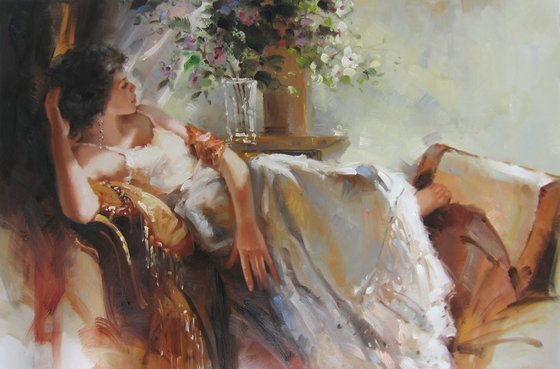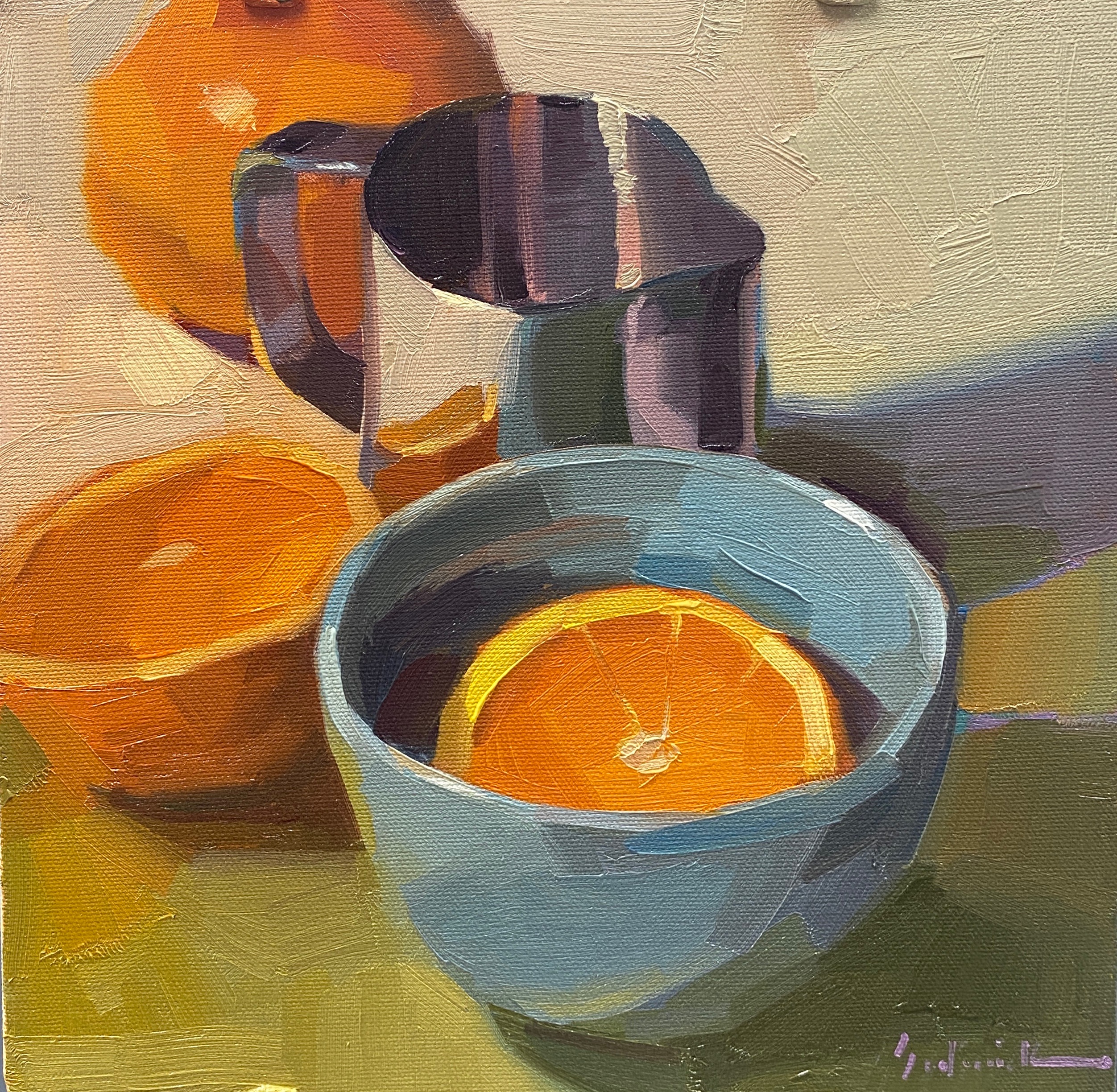Top-Grade Canvas Oil Paintings for Sale Direct from Painters
Top-Grade Canvas Oil Paintings for Sale Direct from Painters
Blog Article
Exploring All About Oil Paintings: An Overview to Comprehending Their Charm and Value
Oil paints have actually mesmerized target markets for centuries, using a glance into the imaginative proficiency of various eras. Their abundant background is intertwined with cutting-edge strategies and profound psychological expression. Recognizing the products and techniques behind these art work can boost gratitude. Furthermore, the marketplace for oil paints offers chances for collectors and capitalists alike. As one discovers this interesting globe, the concern arises: what makes an oil paint truly beneficial?
The Background of Oil Painting: A Trip Through Time
Although oil paint has roots that go back to old times, it genuinely flourished during the Renaissance, when musicians found its flexibility and abundant color capacity. Early instances can be mapped to the 7th century, with strategies advancing significantly throughout societies. The medium came to be prominent in Northern Europe in the 15th century, especially via the jobs of musicians like Jan van Eyck, that pioneered its usage for thorough realistic look and lively colors. This duration marked a departure from tempera paints, enabling for greater depth and structure. As oil paint spread, it affected countless musicians, resulting in masterpieces by popular figures such as Leonardo da Vinci and Rembrandt. The tool's legacy continues, shaping the art globe well right into modern-day times.
Understanding Oil Paints: Materials and Techniques
As artists check out the globe of oil paints, they encounter a diverse selection of products and techniques that specify this medium. The primary components of oil paint consist of pigments, which provide color, and drying oils, such as linseed, that bind the pigments and help with application. Different additives can modify the paint's structure and drying time, enhancing convenience. Strategies like glazing, where clear layers are constructed up, and impasto, which entails using thick paint, permit various aesthetic impacts. Furthermore, making use of brushes, combination knives, and even fingers can create unique structures and finishes. Recognizing these methods and products enables musicians to completely reveal their imagination and accomplish the desired influence in their art work.
The Function of Color in Oil Paints
Shade plays a pivotal duty in oil paintings, affecting both visual allure and emotional vibration. Understanding shade theory fundamentals, including the relationships between hues, can improve a musician's capability to share mood and ambience. Furthermore, mastering color blending methods permits for greater deepness and richness in a painting's scheme.

Shade Concept Essential
Recognizing color theory is essential for musicians collaborating with oil paints, as it develops the structure for producing harmonious and aesthetically appealing structures. Shade theory incorporates the study of exactly how colors engage, the color wheel, and the connections between key, additional, and tertiary colors. Musicians utilize corresponding colors to improve contrasts and create centerpieces, while comparable shades promote unity and cohesiveness within an item. In addition, the concepts of cozy and amazing shades affect the understanding of deepness and area in a paint. Comprehending these principles enables musicians to manipulate shade successfully, leading the audience's eye and communicating their designated message. Mastery of color theory eventually enhances a musician's capacity to communicate feelings and ideas through their work.
Psychological Influence of Shade
The psychological impact of color in oil paintings plays an important duty in how audiences view and attach with artwork. Shades stimulate specific feelings and moods, influencing the visitor's emotion. Warm shades like reds and oranges can produce a feeling of heat and energy, while great tones such as blues and greens commonly stimulate peace or introspection. Artists tactically select shade schemes to enhance narrative elements, guiding the target market's psychological trip. The saturation and contrast of colors further intensify these results, attracting interest and producing focus. Inevitably, the interplay of shades in oil paints not only enhances their visual charm however also works as an effective tool for emotional expression, enriching the visitor's experience and analysis.
Color Combining Techniques
While several facets of oil paint add to the general structure, mastering color blending methods is crucial for attaining desired impacts and depth. Color blending can be approached through numerous techniques, consisting of the subtractive and additive processes. Additive mixing involves combining shades of light, while subtractive blending depends on pigments, where shades mix to produce new tones. Artists typically utilize a minimal scheme to produce harmonious jobs, understanding the relationships between primary, secondary, and tertiary shades. Strategies such as glazing and scumbling better enhance depth and luminosity. By skillfully blending colors, a musician can evoke emotions, develop centerpieces, and accomplish a feeling of realism, inevitably elevating the paint's emotional and visual impact.
Famous Oil Painters and Their Iconic Works

Well known for their mastery of shade and strategy, oil painters have actually produced several of the most well known artworks in history. Renowned artists like Vincent van Gogh astounded target markets with his stirring brushwork in "Starry Evening," while Claude Monet's "Impact, Daybreak" laid the foundation for Impressionism. Leonardo da Vinci's "Mona Lisa" stays a long-lasting sign of artistic genius, showcasing his ability in recording human expression. Meanwhile, Rembrandt's "The Night Watch" highlights his cutting-edge usage of light and shadow. Other remarkable numbers include Pablo Picasso, who revolutionized modern-day art with his vibrant testing in works like "Les Demoiselles d'Avignon," and Georgia O'Keeffe, whose vibrant representations of landscapes and flowers assisted define American modernism. Each musician's one-of-a-kind design contributed significantly to the oil painting landscape.
Just how to Assess the Quality of an Oil Painting
Assessing the quality of an oil painting entails a mindful evaluation of workmanship methods, as well as an analysis of shade and make-up. Observing brushwork, layering, and the application of paint can disclose the musician's skill degree. Additionally, the interaction of colors and the total plan of elements add significantly to the painting's visual value.
Evaluating Workmanship Strategies
A thorough evaluation of craftsmanship techniques is vital for identifying the quality of an oil painting. Critics need to initially examine the application of paint; thick, textured brushstrokes might suggest a competent hand, while overly consistent applications might indicate an absence of deepness. oil paintings for sale. The layering technique is additionally crucial; the presence of lusters and differed thickness can improve brightness and intricacy. Furthermore, the quality of the products used, such as the canvas and pigments, plays a substantial function in resilience and total aesthetic. Focus to detail in components like edges and shifts in between colors mirrors the artist's commitment to their craft. Inevitably, these methods add to the paint's psychological impact and market value, serving as indicators of the artist's skill and intent
Evaluating Color and Make-up
While assessing the high quality of an oil painting, one have to concentrate on the interplay of color and composition, as these aspects are essential to the art work's overall impact. Shade choices can develop and evoke emotions mood; consequently, the artist's combination ought to be taken a look at for consistency and comparison. A well-balanced structure directs the audience's eye and creates a sense of unity. Artists frequently use strategies like the policy of thirds or leading lines to improve aesthetic rate of interest. Furthermore, making use of light and shadow can include deepness, improving the three-dimensionality of the painting. Ultimately, an effective oil paint marries color and structure, involving the customer and welcoming a deeper appreciation of the musician's vision and method.
Caring for and Preserving Oil Paintings
Proper treatment and preservation of oil paintings is essential for keeping their stability and longevity. To shield these artworks, it is crucial to present them far from direct sunshine, which can trigger fading and discoloration. Preserving a steady setting with regulated temperature and moisture additional help in protecting against damage. Cleaning must be done gently using a soft, completely dry towel, preventing any type of rough chemicals that can hurt the paint or varnish. Routine evaluations for signs of deterioration, such as flaking or breaking, are advisable. When transporting or saving oil paintings, correct padding and framework are needed to avoid physical injury. Eventually, persistent treatment adds to the visual allure and value of oil paints gradually.
The Market for Oil Paintings: Investing and accumulating
Comprehending the marketplace dynamics for oil paints is necessary for financiers and enthusiasts alike. The value of these art work is affected by various variables, including the musician's reputation, historic significance, and present trends. Enthusiasts frequently look for pieces that reverberate personally while thinking about possible recognition in worth. Galleries and public auctions offer as key places for trading, with prices fluctuating based on need and rarity. Buying oil paintings calls for research right into the market, as well as an understanding of credibility and provenance. In addition, arising musicians might supply possibilities for substantial returns, while developed names can command high prices. In general, a calculated method to gathering can generate both visual pleasure and financial benefits.

Regularly Asked Inquiries
What Are the Ecological Influences of Oil Paint Products?
The ecological influences of oil paint products consist of the launch of unpredictable natural substances (VOCs), hazardous waste generation, and resource extraction for pigments. These factors contribute to air pollution and eco-friendly destruction, elevating concerns amongst eco conscious musicians and customers.
Exactly How Do Different Canvases Impact Oil Painting Results?
Various canvases influence oil paint results significantly. Surface, texture, and absorbency top quality can change paint application, drying out times, and color vibrancy. Artists typically select particular canvases to achieve wanted impacts and enhance their imaginative expression.
Can Oil Paintings Be Restored if Damaged?
Oil paintings can undoubtedly be restored if harmed. Expert conservators utilize numerous read more techniques to repair tears, tidy surfaces, and address staining, making sure that the artwork preserves its original beauty and worth for future generations.
What Are the Signs of an Original Oil Painting?
The signs of an original oil paint consist of visible brush strokes, appearance variations, and an irregular canvas weave (oil paintings for sale). Furthermore, credibility may be validated through provenance, trademarks, and the presence of a varnish layer one-of-a-kind to oil mediums
Just How Has Innovation Influenced Modern Oil Painting Techniques?
Technology has actually substantially affected contemporary oil painting methods by presenting digital devices for planning, improved products for texture and long life, and online systems for sharing and selling art, therefore increasing musicians' creative possibilities and audience reach. Oil paint has roots that date back to old times, it absolutely grew during the Renaissance, when musicians uncovered its adaptability and rich shade possibility. The emotional effect of color in oil paints plays a critical function in just how visitors attach and view with artwork. While lots of aspects of oil paint contribute to the general make-up, mastering shade blending techniques is necessary for attaining desired results and depth. Examining the quality of an oil paint involves a cautious assessment of craftsmanship methods, as well as an analysis of color and structure. While examining the high quality of an oil paint, one need to concentrate on the interaction of shade and make-up, as these elements are essential to the artwork's total effect.
Report this page